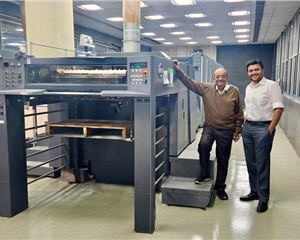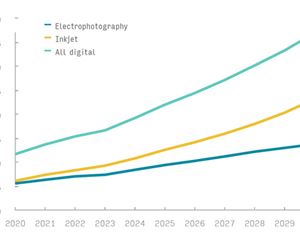PrintWeek-HP webinar explores digital printing in publishing
PrintWeek and HP hosted a webinar on 19 August, focusing on HP's Nonstop Digital Printing: Transforming India's Publishing, Digital Journey. The one-hour knowledge session delivered engaging and insightful discussions on trends, solutions, and growth opportunities within the digital printing landscape.
19 Aug 2025 | By Noel D'Cunha
According to the information PrintWeek has, the Indian digital printing market clocked in USD 1.46-billion. This is expected to double to USD 2.67-billion in seven years. The forecast also placed India’s digital printing at USD 1.4-billion in 2024. This is a CAGR of 7.8% to 2033, and the target is USD 2.9-billion. The momentum is unmistakable. Print On Demand (POD) is gearing up. India’s POD market is showing a solid CAGR.
The webinar featured four speakers — Tony Paguirigan, regional category manager at the Asia Pacific and Japan region, HP PageWide Industrial; Yoav Lotan, head of products and solutions at the Asia Pacific and Japan region, HP; Ashok Pahwa, business manager, commercial business at HP Indigo and PWP inkjet; and Amit Sharma, director, publishing ops at HarperCollins Publishers India.
Tony Paguirigan: HP’s automated book production line
Tony Paguirigan, a product strategist and innovation advocate based in Tokyo, Japan, touched upon accelerate and secure powerful productivity for publishing. As HP PageWide Industrial’s regional category manager for Asia Pacific and Japan (APJ) at HP, Paguirigan has been instrumental in introducing breakthrough technologies and value-driven strategies, driving HP's regional growth and helping customers accelerate their digital transformation. He holds an MBA from the Asian Institute of Management, which has enhanced his strategic thinking, business leadership, and data-driven decision-making capabilities.
In his presentation, Tony Paguirigan announced that for the first time at a trade event, HID25, HP showcased a fully operational automated book production line featuring HP Indigo 120K, HP PageWide Advantage 2200, HP PrintOS, Hunkeler Starbook, H&B Post Coater, and Muller Martini Vareo Pro Perfect Binder.
He highlighted that in 2024, HP announced major innovations across commercial and packaging segments, including the PageWide WebPress Advantage 2200, T485 HD, PageWide Plus Package, T470S, T700i, and T1195i presses.
As part of a major announcement in 2025, Paguirigan introduced the PageWide T4250 HDR for high-volume publishing, direct mail and commercial print, and the PageWide T500M HD for high-volume mono trade books.
He concluded, “At HP, we are on a mission to redefine and shape the future of print, where nonstop digital production becomes the norm. With presses running 24/7, delivering unmatched quality, and every process fully automated and powered by AI, we’re not just erasing the gap between analogue and digital, we’re setting a new standard: Digital-First.”
Earlier, Paguirigan offered an overview of the Indian printing industry. India is the third largest English language publishing market in the world after the US and the UK, and sixth largest globally. Dominated by printing (with digital streaming growing), it has a market value of USD six to seven-million. India has over 21,000 registered publishers, ranging from multinational subsidiaries to small regional presses. Every year, the country produces 90.000 to 100,000 new titles, in more than 20 languages.
“In India, revenue in books market is projected to reach USD 5.83-billion in 2025. This comprises of USD 440-million from Audiobooks, USD 260-million from eBooks and the bulk of it from physical books reaching USD 5.13-bilion US dollars. Revenue in this market is expected to exhibit an annual growth rate (CAGR 2025-2030) of 3.04%, leading to a projected market volume of USD 6.78-billion by 2030,” he said.
Yoav Lotan: The non-stop future
Yoav Lotan, a seasoned leader with over 20 years of experience in the digital print industry across Asia-Pacific and Japan, will present on The Digital Journey: The Non-Stop Future, As the head of the products and solutions team for HP Industrial Print in APJ, Lotan is responsible for the full product portfolio and go-to-market segments strategy, focusing on empowering HP’s partners and customers through commercially grounded innovation and scalable programmes.
Yoav outlined how industrial print is moving towards autonomous presses, AI-powered automation, and nonstop production at the PrintWeek-HP webinar on Nonstop Digital Printing.
Lotan highlighted that with solutions such as AI-based troubleshooting, predictive maintenance, and intelligent workflows, HP Indigo and HP PageWide presses are setting new benchmarks for productivity, sustainability, and personalisation.
He emphasised that HP, with its vast industrial print portfolio, built on two main divisions — Indigo and PageWide Inkjet technology, provides a wide range of solutions in an environment that is constantly changing. He said, “For more than 20 years, we have led different parts of the market, and today we operate globally with over 7,500 presses installed worldwide.”
Looking ahead, Lotan identified four key trends driving growth in digital printing: technological advances, shifting market dynamics, personalisation, and sustainability. He noted, “Every one of our customers is asking for customisation, and there is huge value in this. Our vision is to create solutions for every segment, backed by a clear strategy for each.”
Lotan highlighted that a major investment focus is on automation and AI, intending to scale technologies across all new products and achieve a state of truly autonomous presses.
He mentioned that at Drupa 2024, HP showcased its Intelligent Automation Vision across eight production lines, and already has hundreds of HP Indigo 120K units installed globally.
Ashok Pahwa: Market trends in the book industry
As business manager for HP Indigo and inkjet presses in the Indian subcontinent, Ashok Pahwa leads the strategic direction of the digital press business, focusing on market development, end-to-end go-to- market (GTM) strategies, and driving digital page growth. Pahwa is entrusted with the creation and development of an ecosystem, leveraging a collaborative strategy to drive innovation and accelerate market expansion by effectively integrating key stakeholders— brand, supplier, and consumer—into the value chain with 17 years of which are within the digital print industry, Pahwa possesses expertise in both the commercial and technical aspects of the business.
Pahwa discussed market trends in the book industry, publishers’ strategic requirements and changing demands, and core values of digital print. He said India presents enormous opportunities for printed books and educational content. The publishing industry here is at the heart of a major transformation. The past three years have been defined by resilience. The industry learned to adapt through material shortages, excess inventories and shifting consumer behaviour.
He identified three lessons. Lesson 1: Material planning. After paper supply shocks, publishers now optimise inventory across manufacturing and distribution to stay agile. Lesson 2: Inventory control. Global and Indian publishers are rethinking stock pipelines, reducing excess and improving efficiency. Lesson 3: Changing consumer behaviour. Buying cycles are evolving, forcing publishers to adapt to new preferences and demand patterns.
He said, “Demographics shape demand. With 65% of India’s population under 35, a dynamic, youthful market drives both print and digital growth.”
Highlighting a macro trend, he said, vernacular and regional languages are accelerating, fuelled by the National Education Policy. NCERT reports a 40% surge in Hindi and Tamil textbook editions. He also said that backlist strength matters. “Books older than a year still represent 60–70% of sales in trade publishing, showing titles retain long shelf lives.”
According to Pahwa, sustainability is reshaping publishing. Green books — recyclable materials, no special finishes — are becoming standard in STM and academic segments. Even academic, medical and lifestyle titles now demand vibrant colour, high-quality graphics and more visual impact, driving new print needs. “Digital print is central to meeting these shifts. Four big buckets define its value for publishers,” h said.
He said the bottom line impact. Digital reduces costs by cutting excess inventory, minimising returns and eliminating obsolescence. It also enables no minimum order quantities — print what you want, when you want, where you want. Digital also shortens cycles, supports sampling, revives backlists, and captures unforeseen opportunities quickly. With digital, more SKUs can reach readers faster, aligning with social media buzz, influencer-driven launches and event marketing. Digital also enables personalisation, custom editions and direct engagement.
When it comes to the environment, digital reduces waste, carbon emissions and energy use. Zero obsolescence, no hazardous chemicals, only what’s needed.
“With these advantages, digital providers position themselves not just as printers but as market service partners to publishers,” he said, adding “The next three years will be about consolidating the lessons from the past while scaling digital solutions across publishing. Regional language growth will accelerate, fuelled by NEP reforms and rising demand for culturally relevant, accessible content. The youth demographic — with 65% of India under 35 — will drive demand for educational, career-oriented and lifestyle publishing. Backlists will remain critical, contributing 60–70% of sales, but digital will unlock new revenues by reviving older titles faster. Green books will become mainstream as publishers embrace recyclable materials, lower carbon footprints and reduced waste streams. Personalisation and customisation will move from niche experiments to core strategies, with limited editions and targeted releases. Digital adoption will expand beyond print efficiency into data-driven publishing models, allowing publishers to better understand and serve readers. The industry will see digital-first printers emerge as strategic partners, not just service providers, shaping how content reaches the market.”
Ashok Pahwa in conversation with Dr Amit Sharma
The presentation was following by a tete-a-tete between Ashok Pahwa and Dr Amit Sharma of Harper Collins.
Dr. Amit Sharma is a seasoned operations and supply chain leader with over two decades of experience in managing high-volume, content-driven ecosystems across the publishing, media, and manufacturing sectors. As director, publishing operations at HarperCollins Publishers India, he leads large-scale publishing operations with significant cost and volume responsibilities, spearheading initiatives in cost control, workflow automation, and strategic supplier transformation.
HarperCollins India has been part of the country’s publishing landscape for decades, navigating pivotal moments of growth, localisation and digital adoption. Sharma said, every year, India adds nearly 100,000 new titles across 20+ languages. A massive scale that shapes HarperCollins’ publishing strategy.
Pahwa said educational publishing dominates, making up 60–70% of revenues, but trade publishing contributes 20–25%, with growing demand in regional fiction. Sharma added that books older than a year still account for 60–70% of sales in trade publishing.
Pahwa said NEP reforms are driving regional growth, with NCERT reporting a 40% surge in Hindi and Tamil textbook editions. Sharma added that the youth demographic matters. With 65% of India’s population under 35, demand for educational, career-focused and lifestyle content is surging.
Pahwa said sustainability is rising on the agenda. Green books — recyclable materials, no special finishes — are becoming standard in STM and academic publishing. In this context, Sharma highlighted digital’s promise: cut excess inventory, eliminate obsolescence, reduce returns, and enable “print what you want, when you want, where you want.”
Q&A session
Does HP foresee opportunities for closer collaboration with Indian paper mills to co-develop or certify substrates that can enhance digital printing adoption in India?
Tony Paguirigan: Collaboration with paper mills has always been a pillar of HP’s success, including in India. We already work with several Indian mills — testing, advising and co-developing. HP has programmes where mills can send substrates for testing and certification, or engage in co-development. We encourage ITC to reach out and explore this opportunity further.
What are the key technical attributes to keep in mind while formulating digital inks?
Tony Paguirigan: It’s a broad question. HP has two different ink technologies: Indigo’s electro inks and water-based inks for PageWide. Each involves unique science in formulation and R&D. We can dive deeper in a separate technical session on ink development.
Children’s books are a high-growth segment, but they are design-heavy with high colour coverage. How viable is digital printing for these titles? Is this still offset’s domain?
Ashok Pahwa: Children’s books overlap with categories where HP Indigo already leads — such as coffee table books. For example, Silverpoint in India uses B2 Indigo presses to produce some of the country’s best coffee table titles. The same technology delivers high-coverage, high-quality children’s books. We can even provide proofs of concept and samples for publishers to evaluate.
Tony, you spoke about academic publishing in your presentation, and I would like to know how digital printing helps a publisher manage unpredictable demand and version control, especially since revisions and reprints are frequent in this field. Dr. Sharma, could you also elaborate on whether there are any specific workflows that HP has optimised for this segment?
Tony Paguirigan: This is very relevant today as we see more POD and short-run production. HP, with its workflow partners, has developed solutions to address unpredictable demand, revisions and version control. Depending on publisher needs — time, volume, priority — we can match them with suitable workflow solutions.
Dr Amit Sharma: While my core experience isn’t in academic publishing, I can draw parallels from my time in newspapers. Publishing today mirrors newspapers: faster turnaround, accuracy and timeliness. For publishers, lean processes are key — content is their focus, not file management. With HP-enabled workflows, our print partners give us seamless processes. For example, we can place an order simply by sharing an ISBN and quantity, with files and EDI managed in the background. Journals already do this well, and academic publishing can learn from their model.












 See All
See All